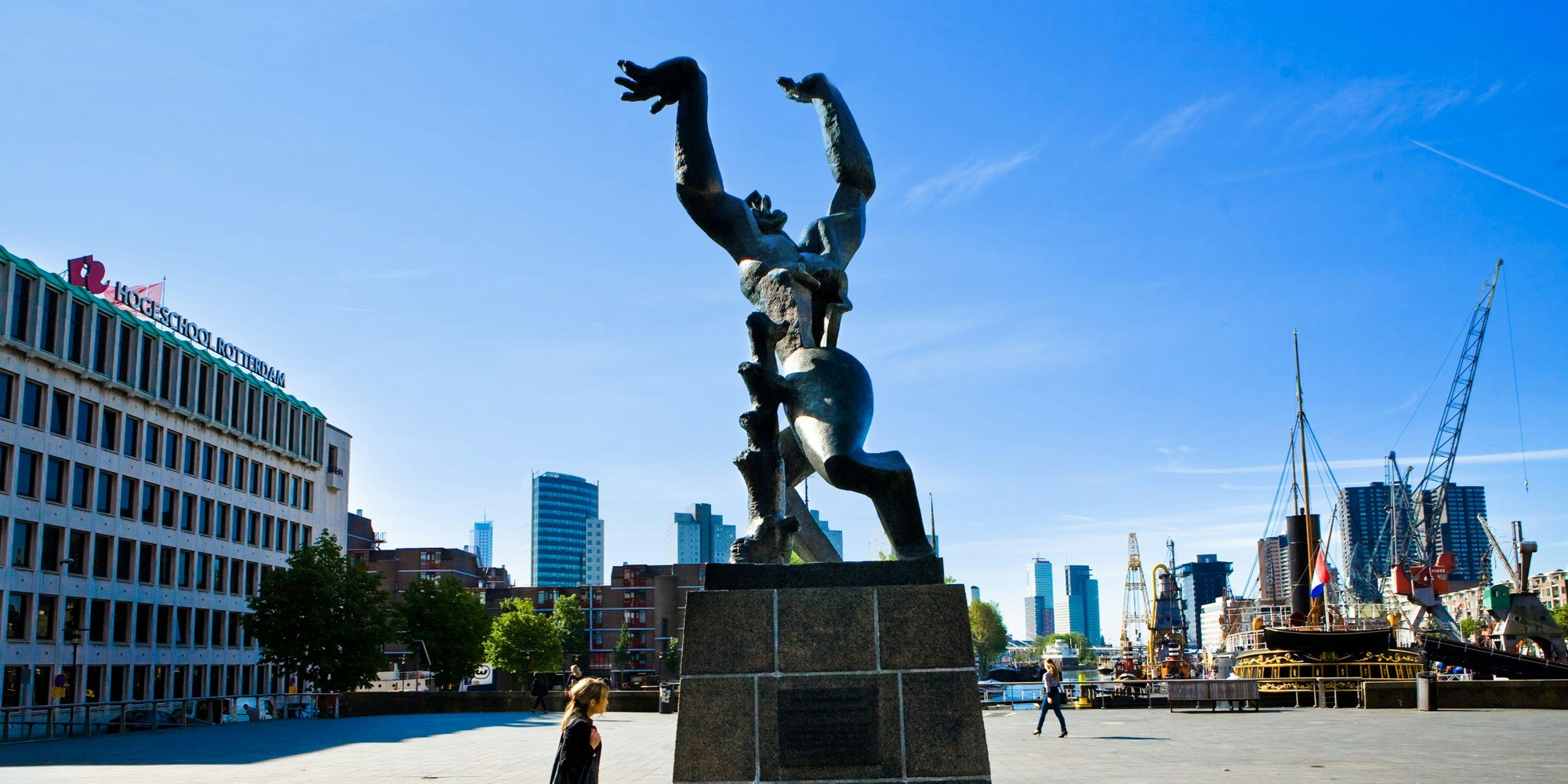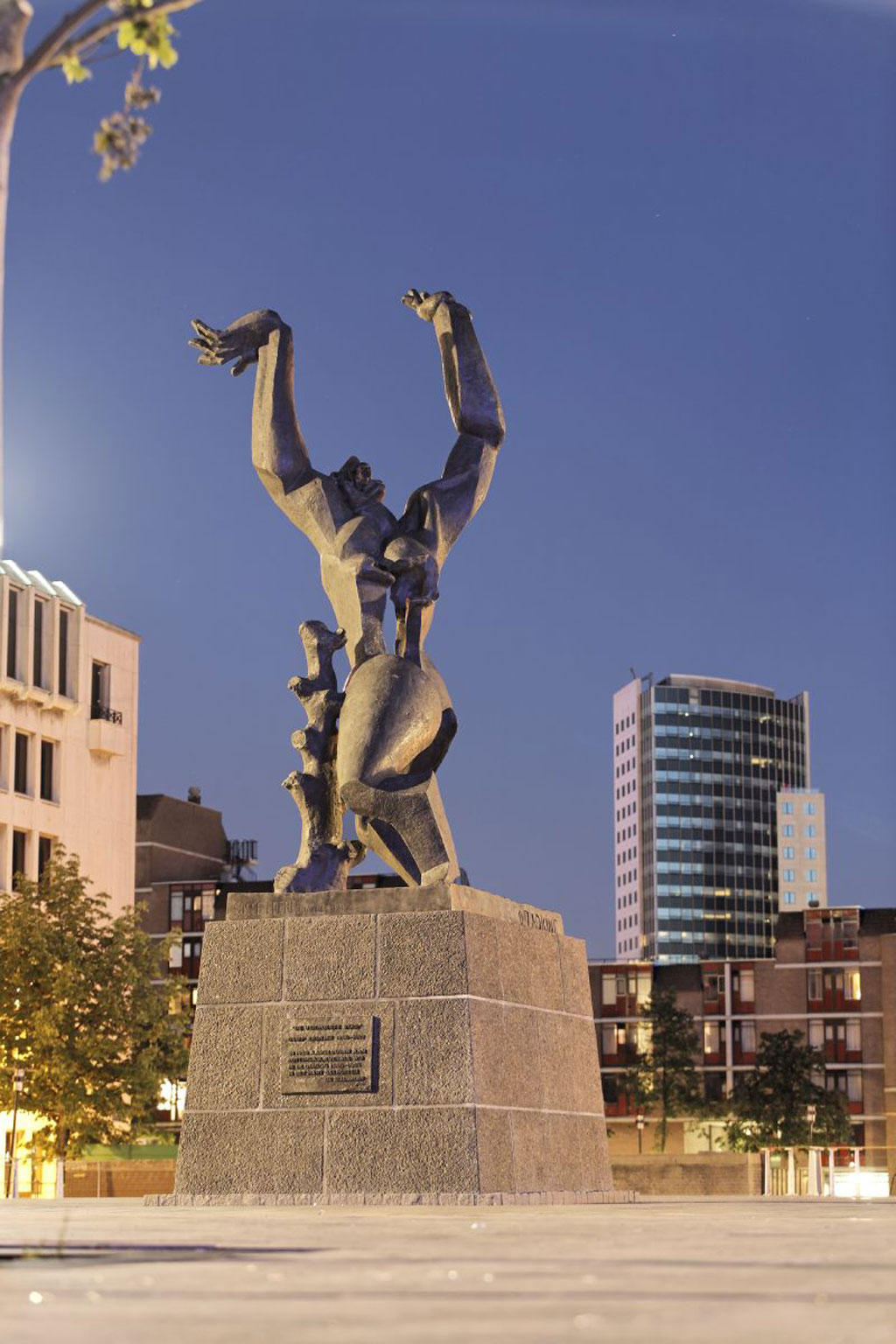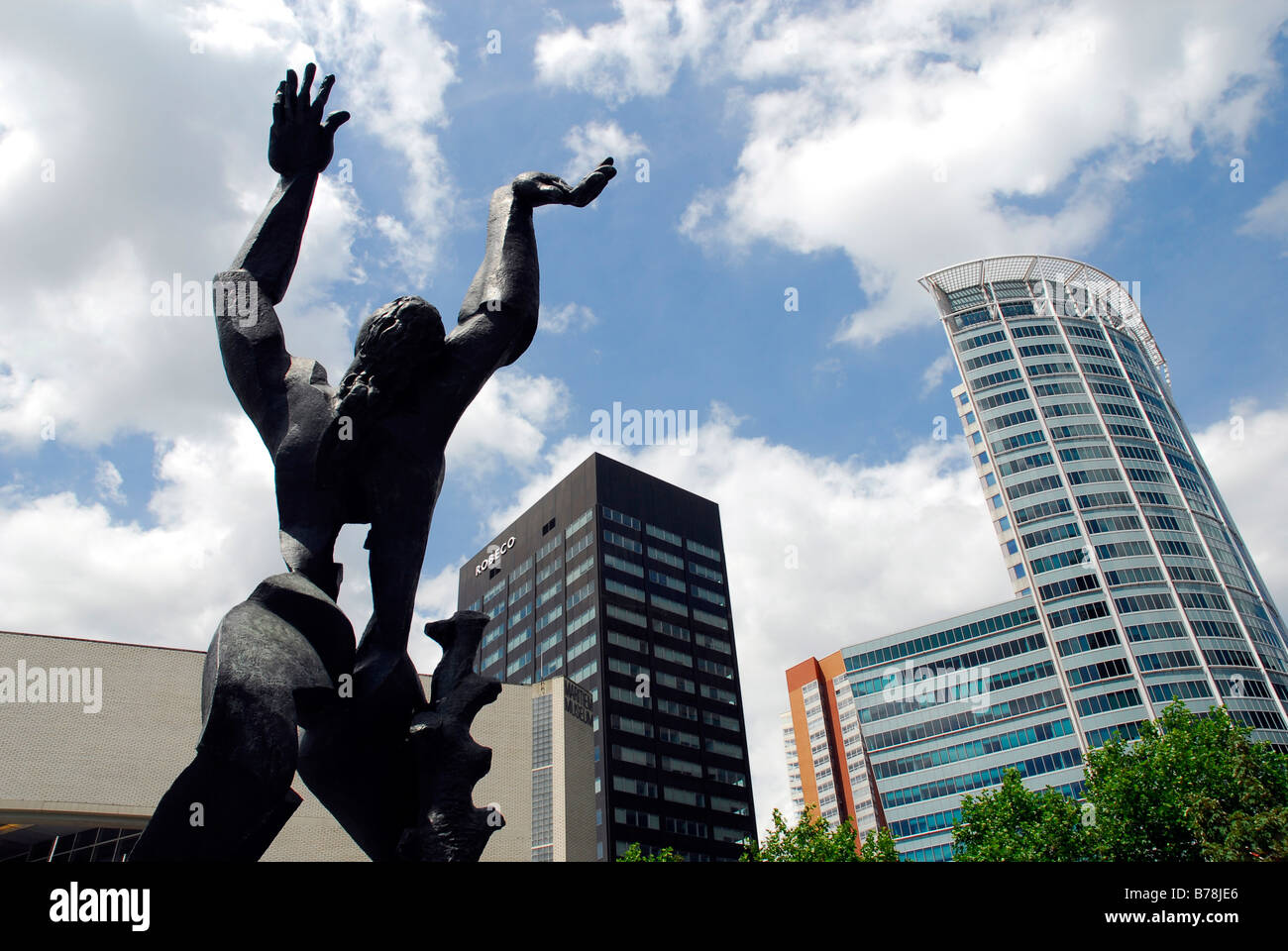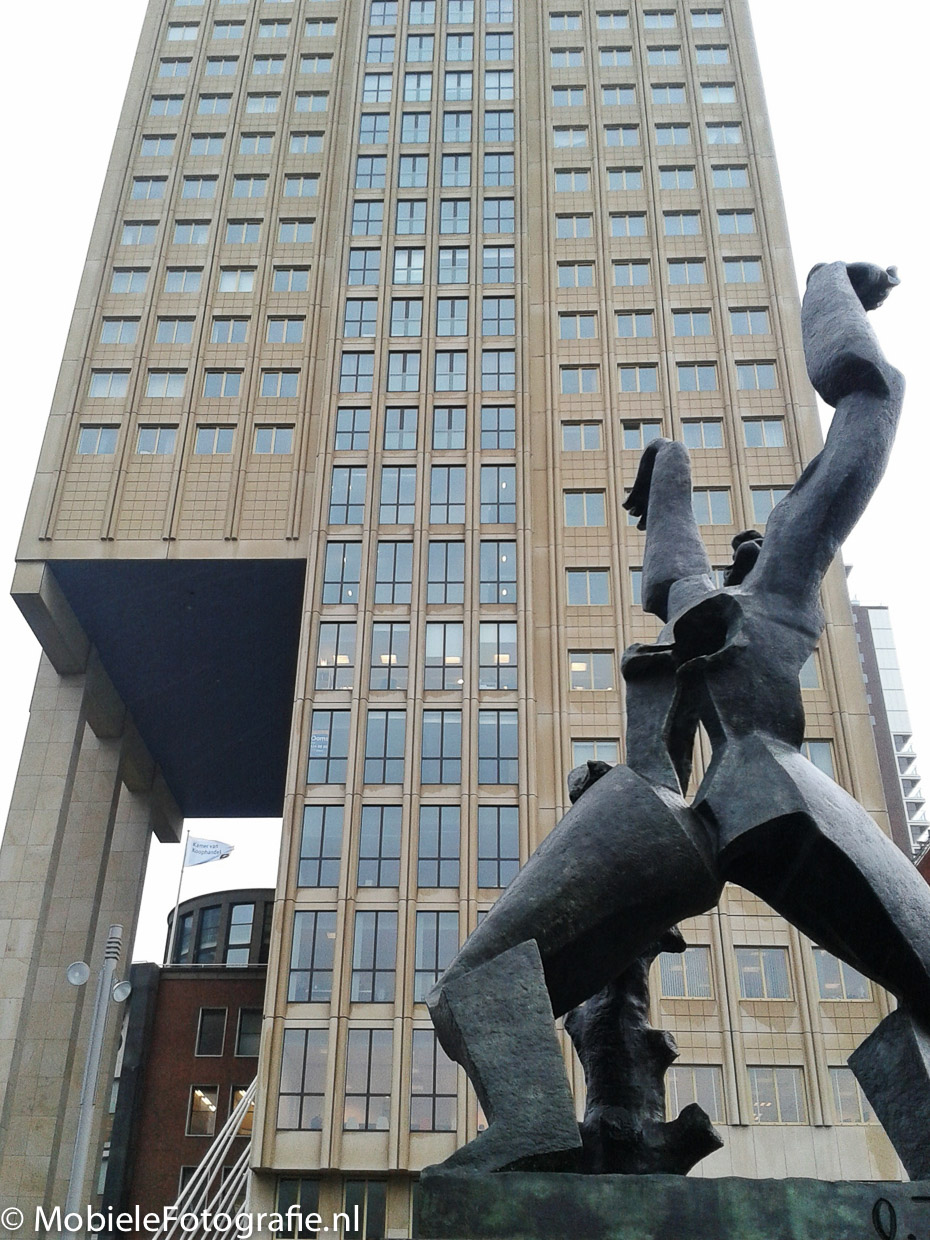
De Verwoeste Stad Rotterdam Info
De Verwoeste Stad (The Destroyed City) by Ossip Zadkine. Image: Ossip Zadkine /Wikimedia Commons/ CC3.0 The Forgotten Bombardment of 1943 Though the Netherlands and Germany are basically BFFs today, het Bombardement has been an important reason why Dutch resentment against Germans lingered for a long time after World War II.

Ossip Zadkine, de verwoeste stad "In Dutch, this sculpture, by Russian Ossip Zapkine, is known
This statue is one of the most famous international war memorials. The destroyed city has become the epitome of the bombed-out Rotterdam. Sculptor Ossip Zadkine made this war memorial in 1947 as a 70 cm high terracotta statue. In 1949, the then director of the Bijenkorf, Mr. Van der Wal, was so impressed by the design,.

De verwoeste stad Sculpture International Rotterdam
Known as The Destroyed City (or De Verwoeste Stad in Dutch), this arresting artwork was created to commemorate the destruction that befell Rotterdam during World War II. On May 10, 1940, the German military, led by the Nazi party and Hitler, invaded the Netherlands in an attempt to occupy the country.

Rotterdam, 'De Verwoeste Stad' Nationaal Comité 4 en 5 mei Nationaal Comité 4 en 5 mei
De verwoeste stad is een beeld dat Ossip Zadkine maakte naar aanleiding van het bombardement op Rotterdam.Het is op 15 mei 1953 onthuld en staat op het Plein 1940, aan de Leuvehaven, naast het Maritiem Museum in Rotterdam.Het beeld is een Rijksmonument.. Naar verluidt kreeg Zadkine de inspiratie voor het beeld De verwoeste stad toen hij vanuit Parijs onderweg was naar zijn vriend, de arts.

De verwoeste stad (1953) Ossip Zadkine Rotterdam Statue, Art history, Rotterdam
He named it De Verwoeste Stad (The Destroyed City, 1953). This bronze statue is over 6 meters tall and depicts a screaming man without a heart. He is in agony and throws his arms desperately in the sky. The missing heart illustrates Rotterdam's destroyed city center, a city without a heart. The statue is special to many people in the city.

Het beeld De Verwoeste Stad Arisca Photography
Delftshaven is a remarkable piece of Rotterdam, a bit to the west of the city center. In the 14th century, Delftshaven emerged when a canal was dug from Delft to the river Maas. It became the harbor of Delft, hence the name. But Delft is almost 15 kilometers away. The harbor grew as a wealthy, more or less independent little city.

De Verwoeste Stad, the devastated city, Monument of Zadkine, Churchillplein, Rotterdam, South
The "Destroyed City" (or De Verwoeste Stad in Dutch) is a 6.5m-high bronze statue created by Ossip Zadkine. Zadkine was born in Russia in 1890, and lived in Paris during the war as an artist and sculpture. He was inspired to create the sculpture after visiting the destroyed remains of Rotterdam when traveling to the city by train after the.

ArtSite In ons geheugen gegrift De Verwoeste Stad, Ossip Zadkine
De Verwoeste Stad, (The Destroyed City), sculpture in Rotterdam by Ossip Zadkine. Ossip Zadkine - CC BY-SA 3.0. Although it took almost four decades for the city to fully get back on its feet, many now believe Rotterdam is better than ever. Though the city has moved on from this dark time, it doesn't shy away from its past.

Pin op Beelden op straat Sculpture in the street
De verwoeste stad is een beeld dat Ossip Zadkine maakte naar aanleiding van het bombardement op Rotterdam. Het is op 15 mei 1953 onthuld en staat op het Plein 1940, aan de Leuvehaven in Rotterdam, naast het Maritiem Museum. Het bronzen beeld stelt een menselijk figuur voor zonder hart, als symbool voor het hart van Rotterdam dat werd verwoest.

De verwoeste stad BKOR De verwoeste stad
The Destroyed City (Dutch: De verwoeste stad) is a bronze memorial sculpture in the Dutch city of Rotterdam. It commemorates the German bombing of Rotterdam on 14 May 1940, which destroyed the medieval centre of the city. [1] Unveiled in 1953, it was designated as a Dutch national monument ( Rijksmonument) in 2010.

mobiele fotografie rotterdam 'De Verwoeste Stad' Zadkine Mobielefotografie.nl
English: De Verwoeste Stad is a bronze sculpture made in 1953 by Ossip Zadkine for the Dutch City of Rotterdam, in rememberance of the bombing and destruction of the old city-center in May 1940 by the German "Luftwaffe", in the first days of the Dutch occupation (ending in May 1945) by the Germans during World War II.

Ossip Zadkine De verwoeste stad uit 1951, symbool voor de verwoesting in de Tweede wereldoorlog
Rotterdam was subjected to heavy aerial bombardment by the Luftwaffe during the German invasion of the Netherlands during the Second World War. The objective was to support the German troops fighting in the city, break Dutch resistance and force the Dutch army to surrender. Bombing began at the outset of hostilities on 10 May and culminated.

De verwoeste stad Beroemde beelden in Rotterdam Alles over Kunstenaars
The De Verwoeste Stad in Rotterdam shows a desperate human with the hands towards the sky. As a symbol of the destroyed Rotterdam city center the hole in the human's chest is where the heart belongs. The tree trunk supports the human. The statue is in the Abstract Expressionism art style. The statue's purchase and anonymous donation was by.

Standbeeld in Rotterdam van de verwoeste stad in de oorlog! Standbeeld, Monumenten, Stad
Known as The Destroyed City (or De Verwoeste Stad in Dutch), this arresting artwork was created to commemorate the destruction that befell Rotterdam during World War II. On May 10, 1940, the German military, led by the Nazi party and Hitler, invaded the Netherlands in an attempt to occupy the country. After encountering significant resistance.

"De Verwoeste Stad" sculpture by Zadkine (18901967) in Rotterdam, The Netherlands Stock Photo
Verbeterde statische ondertiteling! Abonneer - Subscribe here : https://bit.ly/2NMwb6q Nederlandse ondertiteling - English spoken.De verwoeste stad is volgen.

De verwoeste stad Museum Rotterdam
Rotterdam: statue "De Verwoeste Stad" by O. Zadkin (1953) during restauration, May 2005. Own photo, May 13, 2005. This file is licensed under the Creative Commons Attribution 1.0 Generic license. You are free: to share - to copy, distribute and transmit the work;